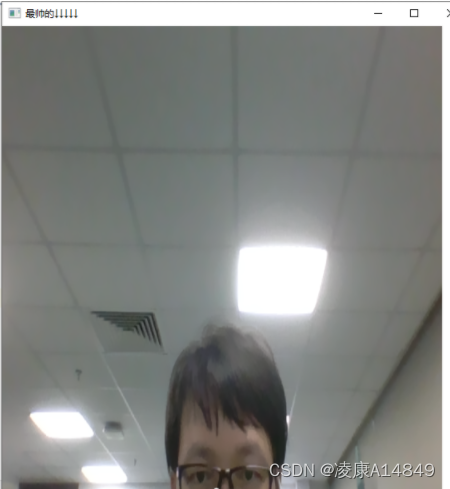人脸智能美型技术主要用于智能美颜,对用户的照片进行自动智能调整,而不需要用户手工调整,该技术在美颜相机、天天P图等app中都已应用。
本文在这里对人脸智能美型做个详解。
人脸智能美型包含如下两个部分:
①人脸轮廓自动调整
②五官自动修正
人脸轮廓自动修正:对人脸大小,胖瘦进行自动调整,目前app中常用的瘦脸只是其中一个特例而已;
五官自动修正:包含眼睛大小自动调整,鼻子形状位置修正,眉毛位置修正以及嘴巴形状、大小和位置自动修正等等。App中常用的大眼和立体修鼻功能,也属于其中一个特例;
人脸智能美型和磨皮美白结合使用,就是所谓的智能美颜。
人脸智能美型算法逻辑如下:
1,构建平均脸
针对男女分别构建正脸平均脸,如下图所示:
2,性别识别
这一步需要将用户的人像照片进行性别识别,根据识别结果分别选择男/女平均脸数据。
性别识别可以参考本人博客:性别识别
核心代码如下:
def weight_variable(shape,name):return tf.Variable(tf.truncated_normal(shape, stddev = 0.1),name=name)def bias_variable(shape,name):return tf.Variable(tf.constant(0.1, shape = shape),name=name)def conv2d(x,w,padding="SAME"):if padding=="SAME" :return tf.nn.conv2d(x, w, strides = [1,1,1,1], padding = "SAME")else:return tf.nn.conv2d(x, w, strides = [1,1,1,1], padding = "VALID")def max_pool(x, kSize, Strides):return tf.nn.max_pool(x, ksize = [1,kSize,kSize,1],strides = [1,Strides,Strides,1], padding = "SAME") def compute_cost(Z3, Y):"""Computes the costArguments:Z3 -- output of forward propagation (output of the last LINEAR unit), of shape (6, number of examples)Y -- "true" labels vector placeholder, same shape as Z3Returns:cost - Tensor of the cost function"""cost = tf.reduce_mean(tf.nn.softmax_cross_entropy_with_logits(logits=Z3, labels=Y)) return costdef initialize_parameters():tf.set_random_seed(1)W1 = tf.cast(weight_variable([5,5,1,32],"W1"), dtype = tf.float32)b1 = tf.cast(bias_variable([32],"b1"), dtype = tf.float32)W2 = tf.cast(weight_variable([5,5,32,64],"W2"), dtype = tf.float32)b2 = tf.cast(bias_variable([64],"b2"), dtype = tf.float32)W3 = tf.cast(weight_variable([5,5,64,128],"W3"), dtype = tf.float32)b3 = tf.cast(bias_variable([128],"b3"), dtype = tf.float32)W4 = tf.cast(weight_variable([14*12*128,500],"W4"), dtype = tf.float32)b4 = tf.cast(bias_variable([500],"b4"), dtype = tf.float32)W5 = tf.cast(weight_variable([500,500],"W5"), dtype = tf.float32)b5 = tf.cast(bias_variable([500],"b5"), dtype = tf.float32)W6 = tf.cast(weight_variable([500,2],"W6"), dtype = tf.float32)b6 = tf.cast(bias_variable([2],"b6"), dtype = tf.float32)parameters = {"W1":W1,"b1":b1,"W2":W2,"b2":b2,"W3":W3,"b3":b3,"W4":W4,"b4":b4,"W5":W5,"b5":b5,"W6":W6,"b6":b6}return parametersdef cnn_net(x, parameters, keep_prob = 1.0):#frist convolution layerw_conv1 = parameters["W1"]b_conv1 = parameters["b1"]h_conv1 = tf.nn.relu(conv2d(x,w_conv1) + b_conv1) #output size 112x92x32h_pool1 = max_pool(h_conv1,2,2) #output size 56x46x32#second convolution layerw_conv2 = parameters["W2"]b_conv2 = parameters["b2"]h_conv2 = tf.nn.relu(conv2d(h_pool1, w_conv2) + b_conv2) #output size 56x46x64h_pool2 = max_pool(h_conv2,2,2) #output size 28x23x64#third convolution layerw_conv3 = parameters["W3"]b_conv3 = parameters["b3"]h_conv3 = tf.nn.relu(conv2d(h_pool2,w_conv3) + b_conv3) #output size 28x23x128h_pool3 = max_pool(h_conv3,2,2) #output size 14x12x128#full convolution layer w_fc1 = parameters["W4"]b_fc1 = parameters["b4"]h_fc11 = tf.reshape(h_pool3,[-1,14*12*128])h_fc1 = tf.nn.relu(tf.matmul(h_fc11,w_fc1) + b_fc1)w_fc2 = parameters["W5"]b_fc2 = parameters["b5"]h_fc2 = tf.nn.relu(tf.matmul(h_fc1,w_fc2)+b_fc2)h_fc2_drop = tf.nn.dropout(h_fc2,keep_prob)w_fc3 = parameters["W6"]b_fc3 = parameters["b6"]y_conv = tf.matmul(h_fc2_drop, w_fc3) + b_fc3#y_conv = tf.nn.softmax(tf.matmul(h_fc2_drop, w_fc3) + b_fc3)#rmse = tf.sqrt(tf.reduce_mean(tf.square(y_ - y_conv)))#cross_entropy = tf.reduce_mean(tf.nn.softmax_cross_entropy_with_logits(labels = y, logits = y_conv))#train_step = tf.train.GradientDescentOptimizer(0.001).minimize(cross_entropy)#correct_prediction = tf.equal(tf.argmax(y_conv, 1), tf.argmax(y,1))#accuracy = tf.reduce_mean(tf.cast(correct_prediction, tf.float32))
3,将用户照片人脸映射到平均脸
这一步主要根据用户照片人脸关键点和平均脸的人脸关键点,加上一定的映射算法将用户照片对齐到平均脸中,可以参考仿射变换等。
关键点可以使用商汤科技或者FACE++等人脸SDK。
效果如下图所示:
4,计算用户人脸和平均脸的距离D
此处计算规则可以使用欧氏距离等,距离D表示用户人脸到完美人脸的差。
距离的计算还需要参考人脸的旋转角度信息,根据人脸旋转角度对距离进行加权处理,以此来适应各种角度的用户人脸照片。
5,根据D对用户人脸进行不同程度的变形,得到智能美型结果
此处变形可以使用MLS、三角网格变形等等。
MLS详细算法与代码,可参考博客:MLS变形
MLS核心代码如下:
static void setSrcPoints(const vector<PointD> &qsrc, vector<PointD> &newDotL, int* nPoint) {*nPoint = qsrc.size();newDotL.clear();newDotL.reserve(*nPoint);for (size_t i = 0; i < qsrc.size(); i++) newDotL.push_back(qsrc[i]);
}static void setDstPoints(const vector<PointD> &qdst,vector<PointD> &oldDotL, int* nPoint) {*nPoint = qdst.size();oldDotL.clear();oldDotL.reserve(*nPoint);for (size_t i = 0; i < qdst.size(); i++) oldDotL.push_back(qdst[i]);
}
static double bilinear_interp(double x, double y, double v11, double v12,double v21, double v22) {return (v11 * (1 - y) + v12 * y) * (1 - x) + (v21 * (1 - y) + v22 * y) * x;
}static double calcArea(const vector<PointD> &V) {PointD lt, rb;lt.x = lt.y = 1e10;rb.x = rb.y = -1e10;for (vector<PointD >::const_iterator i = V.begin(); i != V.end();i++) {if (i->x < lt.x) lt.x = i->x;if (i->x > rb.x) rb.x = i->x;if (i->y < lt.y) lt.y = i->y;if (i->y > rb.y) rb.y = i->y;}return (rb.x - lt.x) * (rb.y - lt.y);
}
static void calcDelta_rigid(int srcW, int srcH, int tarW, int tarH, double alpha, int gridSize, int nPoint, int preScale, double *rDx, double *rDy, vector<PointD> &oldDotL, vector<PointD> &newDotL)
{int i, j, k;PointD swq, qstar, newP, tmpP;double sw;double ratio;if (preScale) {ratio = sqrt(calcArea(newDotL) / calcArea(oldDotL));for (i = 0; i < nPoint; i++) {newDotL[i].x *= 1 / ratio;newDotL[i].y *= 1 / ratio;}}double *w = new double[nPoint];if (nPoint < 2) {//rDx.setTo(0);//rDy.setTo(0);return;}PointD swp, pstar, curV, curVJ, Pi, PiJ, Qi;double miu_r;for (i = 0;; i += gridSize) {if (i >= tarW && i < tarW + gridSize - 1)i = tarW - 1;else if (i >= tarW)break;for (j = 0;; j += gridSize) {if (j >= tarH && j < tarH + gridSize - 1)j = tarH - 1;else if (j >= tarH)break;sw = 0;swp.x = swp.y = 0;swq.x = swq.y = 0;newP.x = newP.y = 0;curV.x = i;curV.y = j;for (k = 0; k < nPoint; k++) {if ((i == oldDotL[k].x) && j == oldDotL[k].y) break;if (alpha == 1)w[k] = 1 / ((i - oldDotL[k].x) * (i - oldDotL[k].x) +(j - oldDotL[k].y) * (j - oldDotL[k].y));elsew[k] = pow((i - oldDotL[k].x) * (i - oldDotL[k].x) +(j - oldDotL[k].y) * (j - oldDotL[k].y),-alpha);sw = sw + w[k];swp.x = swp.x + w[k] * oldDotL[k].x;swp.y = swp.y + w[k] * oldDotL[k].y;swq.x = swq.x + w[k] * newDotL[k].x;swq.y = swq.y + w[k] * newDotL[k].y;}if (k == nPoint) {pstar.x = (1 / sw) * swp.x;pstar.y = (1 / sw) * swp.y;qstar.x = 1 / sw * swq.x;qstar.y = 1 / sw * swq.y;// Calc miu_rdouble s1 = 0, s2 = 0;for (k = 0; k < nPoint; k++) {if (i == oldDotL[k].x && j == oldDotL[k].y) continue;Pi.x = oldDotL[k].x - pstar.x;Pi.y = oldDotL[k].y - pstar.y;PiJ.x = -Pi.y, PiJ.y = Pi.x;Qi.x = newDotL[k].x - qstar.x;Qi.y = newDotL[k].y - qstar.y;s1 += w[k] * (Qi.x*Pi.x+Qi.y*Pi.y);s2 += w[k] * (Qi.x*PiJ.x+Qi.y*PiJ.y);}miu_r = sqrt(s1 * s1 + s2 * s2);curV.x -= pstar.x;curV.y -= pstar.y;curVJ.x = -curV.y, curVJ.y = curV.x;for (k = 0; k < nPoint; k++) {if (i == oldDotL[k].x && j == oldDotL[k].y) continue;Pi.x = oldDotL[k].x - pstar.x;Pi.y = oldDotL[k].y - pstar.y;PiJ.x = -Pi.y, PiJ.y = Pi.x;tmpP.x = (Pi.x*curV.x+Pi.y*curV.y)* newDotL[k].x -(PiJ.x*curV.x+PiJ.y*curV.y)* newDotL[k].y;tmpP.y = -(Pi.x*curVJ.x+Pi.y*curVJ.y) * newDotL[k].x +(PiJ.x*curVJ.x+PiJ.y*curVJ.y) * newDotL[k].y;tmpP.x *= w[k] / miu_r;tmpP.y *= w[k] / miu_r;newP.x += tmpP.x;newP.y += tmpP.y;}newP.x += qstar.x;newP.y += qstar.y;} else {newP = newDotL[k];}if (preScale) {rDx[j * tarW + i] = newP.x * ratio - i;rDy[j * tarW + i] = newP.y * ratio - j;} else {rDx[j * tarW + i] = newP.x - i;rDy[j * tarW + i] = newP.y - j;}}}delete[] w;if (preScale!=0) {for (i = 0; i < nPoint; i++){newDotL[i].x *= ratio;newDotL[i].y *= ratio;}}
}
static void calcDelta_Similarity(int srcW, int srcH, int tarW, int tarH, double alpha, int gridSize, int nPoint, int preScale, double *rDx, double *rDy, vector<PointD> &oldDotL, vector<PointD> &newDotL)
{int i, j, k;PointD swq, qstar, newP, tmpP;double sw;double ratio;if (preScale) {ratio = sqrt(calcArea(newDotL) / calcArea(oldDotL));for (i = 0; i < nPoint; i++) {newDotL[i].x *= 1 / ratio;newDotL[i].y *= 1 / ratio;}}double *w = new double[nPoint];if (nPoint < 2) {return;}PointD swp, pstar, curV, curVJ, Pi, PiJ;double miu_s;for (i = 0;; i += gridSize) {if (i >= tarW && i < tarW + gridSize - 1)i = tarW - 1;else if (i >= tarW)break;for (j = 0;; j += gridSize) {if (j >= tarH && j < tarH + gridSize - 1)j = tarH - 1;else if (j >= tarH)break;sw = 0;swp.x = swp.y = 0;swq.x = swq.y = 0;newP.x = newP.y = 0;curV.x = i;curV.y = j;for (k = 0; k < nPoint; k++) {if ((i == oldDotL[k].x) && j == oldDotL[k].y) break;w[k] = 1 / ((i - oldDotL[k].x) * (i - oldDotL[k].x) +(j - oldDotL[k].y) * (j - oldDotL[k].y));sw = sw + w[k];swp.x = swp.x + w[k] * oldDotL[k].x;swp.y = swp.y + w[k] * oldDotL[k].y;swq.x = swq.x + w[k] * newDotL[k].x;swq.y = swq.y + w[k] * newDotL[k].y;}if (k == nPoint) {pstar.x = (1 / sw) * swp.x;pstar.y = (1 / sw) * swp.y;qstar.x = 1 / sw * swq.x;qstar.y = 1 / sw * swq.y;// Calc miu_smiu_s = 0;for (k = 0; k < nPoint; k++) {if (i == oldDotL[k].x && j == oldDotL[k].y) continue;Pi.x = oldDotL[k].x - pstar.x;Pi.y = oldDotL[k].y - pstar.y;miu_s += w[k] * (Pi.x*Pi.x+Pi.y*Pi.y);}curV.x -= pstar.x;curV.y -= pstar.y;curVJ.x = -curV.y, curVJ.y = curV.x;for (k = 0; k < nPoint; k++) {if (i == oldDotL[k].x && j == oldDotL[k].y) continue;Pi.x = oldDotL[k].x - pstar.x;Pi.y = oldDotL[k].y - pstar.y;PiJ.x = -Pi.y, PiJ.y = Pi.x;tmpP.x = (Pi.x*curV.x+Pi.y*curV.y) * newDotL[k].x -(PiJ.x*curV.x+PiJ.y*curV.y) * newDotL[k].y;tmpP.y = -(Pi.x*curVJ.x+Pi.y*curVJ.y) * newDotL[k].x +(PiJ.x*curVJ.x+PiJ.y*curVJ.y) * newDotL[k].y;tmpP.x *= w[k] / miu_s;tmpP.y *= w[k] / miu_s;newP.x += tmpP.x;newP.y += tmpP.y;}newP.x += qstar.x;newP.y += qstar.y;} else {newP = newDotL[k];}rDx[j * tarW + i] = newP.x - i; rDy[j * tarW + i] = newP.y - j;}}delete[] w;if (preScale!=0) {for (i = 0; i < nPoint; i++){newDotL[i].x *= ratio;newDotL[i].y *= ratio;}}
}
static int GetNewImg(unsigned char* oriImg, int width, int height, int stride, unsigned char* tarImg, int tarW, int tarH, int tarStride, int gridSize, double* rDx, double* rDy, double transRatio)
{int i, j;double di, dj;double nx, ny;int nxi, nyi, nxi1, nyi1;double deltaX, deltaY;double w, h;int ni, nj;int pos, posa, posb, posc, posd;for (i = 0; i < tarH; i += gridSize)for (j = 0; j < tarW; j += gridSize) {ni = i + gridSize, nj = j + gridSize;w = h = gridSize;if (ni >= tarH) ni = tarH - 1, h = ni - i + 1;if (nj >= tarW) nj = tarW - 1, w = nj - j + 1;for (di = 0; di < h; di++)for (dj = 0; dj < w; dj++) {deltaX =bilinear_interp(di / h, dj / w, rDx[i * tarW + j], rDx[i * tarW + nj],rDx[ni * tarW + j], rDx[ni * tarW + nj]);deltaY =bilinear_interp(di / h, dj / w, rDy[i * tarW + j], rDy[i * tarW + nj],rDy[ni * tarW + j], rDy[ni * tarW + nj]);nx = j + dj + deltaX * transRatio;ny = i + di + deltaY * transRatio;if (nx > width - 1) nx = width - 1;if (ny > height - 1) ny = height - 1;if (nx < 0) nx = 0;if (ny < 0) ny = 0;nxi = int(nx);nyi = int(ny);nxi1 = ceil(nx);nyi1 = ceil(ny);pos = (int)(i + di) * tarStride + ((int)(j + dj) << 2);posa = nyi * stride + (nxi << 2);posb = nyi * stride + (nxi1 << 2);posc = nyi1 * stride + (nxi << 2);posd = nyi1 * stride + (nxi1 << 2);tarImg[pos] = (unsigned char)bilinear_interp(ny - nyi, nx - nxi, oriImg[posa], oriImg[posb], oriImg[posc], oriImg[posd]);tarImg[pos + 1] = (unsigned char)bilinear_interp(ny - nyi, nx - nxi, oriImg[posa + 1],oriImg[posb + 1], oriImg[posc + 1], oriImg[posd + 1]);tarImg[pos + 2] = (unsigned char)bilinear_interp(ny - nyi, nx - nxi, oriImg[posa + 2],oriImg[posb + 2], oriImg[posc + 2], oriImg[posd + 2]);tarImg[pos + 3] = (unsigned char)bilinear_interp(ny - nyi, nx - nxi, oriImg[posa + 3],oriImg[posb + 3], oriImg[posc + 3], oriImg[posd + 3]);}}return 0;
};static void MLSImageWrapping(unsigned char* oriImg,int width, int height, int stride,const vector<PointD > &qsrc, const vector<PointD > &qdst, unsigned char* tarImg, int outW, int outH, int outStride, double transRatio, int preScale, int gridSize, int method)
{int srcW = width;int srcH = height;int tarW = outW;int tarH = outH;double alpha = 1;int nPoint;int len = tarH * tarW;vector<PointD> oldDotL, newDotL;double *rDx = NULL,*rDy = NULL;setSrcPoints(qsrc,newDotL,&nPoint);setDstPoints(qdst,oldDotL,&nPoint);rDx = (double*)malloc(sizeof(double) * len);rDy = (double*)malloc(sizeof(double) * len);memset(rDx, 0, sizeof(double) * len);memset(rDy, 0, sizeof(double) * len);if(method!=0)calcDelta_Similarity(srcW, srcH, tarW, tarH, alpha, gridSize, nPoint, preScale, rDx, rDy, oldDotL, newDotL);elsecalcDelta_rigid(srcW, srcH, tarW, tarH, alpha, gridSize, nPoint, preScale, rDx, rDy, oldDotL, newDotL);GetNewImg(oriImg, srcW, srcH, stride, tarImg, tarW, tarH, outStride, gridSize, rDx, rDy, transRatio);if(rDx != NULL)free(rDx);if(rDy != NULL)free(rDy);
};
int f_TMLSImagewarpping(unsigned char* srcData, int width ,int height, int stride, unsigned char* dstData, int outW, int outH, int outStride, int srcPoint[], int dragPoint[], int pointNum, double intensity, int preScale, int gridSize, int method)
{int res = 0;vector<PointD> qDst;vector<PointD> qSrc;PointD point = {0};int len = 0;for(int i = 0; i < pointNum; i++){len = (i << 1);point.x = srcPoint[len];point.y = srcPoint[len + 1];qSrc.push_back(point);point.x = dragPoint[len];point.y = dragPoint[len + 1];qDst.push_back(point);}MLSImageWrapping(srcData, width, height, stride, qSrc, qDst, dstData, outW, outH, outStride, intensity, preScale,gridSize, method);return res;
};上述过程就是人脸自动美型的算法逻辑,对于不同的人像照片,会自动判断大眼矫正或者小眼矫正,瘦脸或者胖脸等等,综合达到一个相对完美的结果。
自动美型效果如下图所示:
最后,本人QQ1358009172,微信公众号:SF图像算法,欢迎学习交流!







